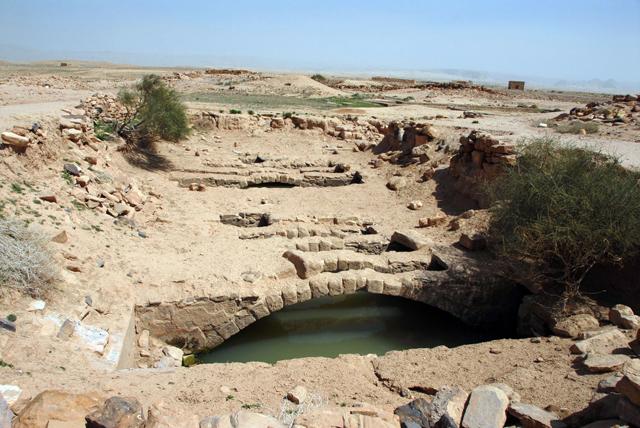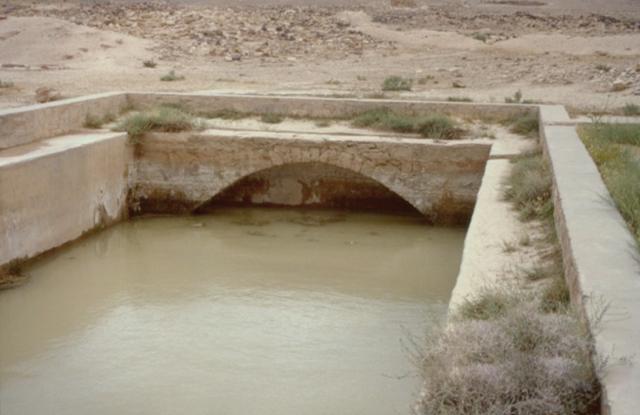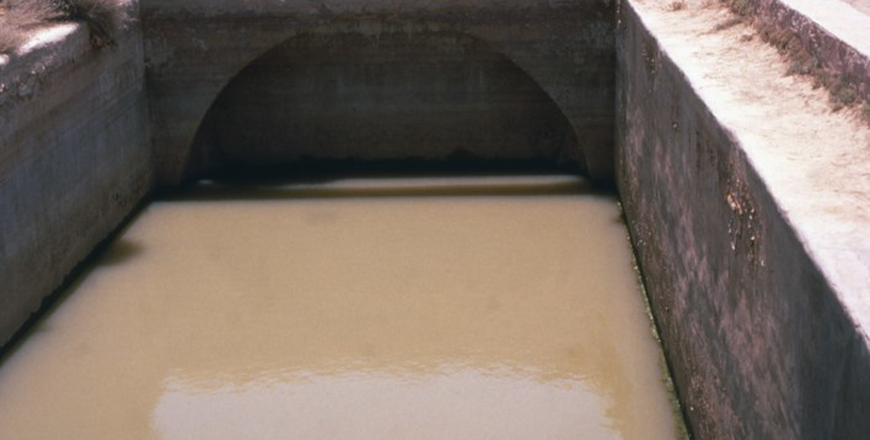You are here
Canadian scholar examines ‘Nabataean colony of Humayma’
By Saeb Rawashdeh - Apr 07,2017 - Last updated at Apr 07,2017

A Nabataean cistern in Humayma, 280km south of Amman (Photo courtesy of John P. Oleson )
AMMAN — Despite no “direct literary sources”, a Canadian scholar is piecing together archaeological clues to the origins of the ancient settlement of Humayma in southern Jordan.
The first settlement at Humayma, 280km south of Amman and 40km south of Petra, was founded by Prince Aretas, son of King Obodas, noted Professor John P. Oleson from the University of Victoria in Canada.
It was probably Aretas IV — ruled 9/8 BC to 39/40 AD — the Canadian archaeologist stressed, adding that “we have no literary sources by or about the early settlers, but they were Nabataeans, using pottery and coinage from Petra, and providing a small number of inscriptions in the Nabataean language”.
The town was named “Hawara,” meaning “white” in Aramaic, a name associated with the foundation myth involving a man clothed in white riding a white camel, he continued.
“I think the hump-shaped white sandstone hills nearby might also have something to do with the name. The settlement clearly prospered, to judge by the surviving fragments of public and private architecture, supported by agriculture, stock raising and probably bytolls levied on passing caravans,” Oleson stated.
The Nabataeans built around 60 cisterns and reservoirs in the region, filled by run-off water from the winter rains, while King Aretas also built 27km of aqueduct channel to bring water from three springs on Al Shera escarpment, the scholar underlined.
Regarding the link between Petra and ancient Hawara, there is no direct inscriptional or historical testimony to the relationship, but it is clear that Hawara was a colony of Petra, the scholar pointed out, as it was founded by a Nabataean prince on the orders of his father, the pottery throughout the settlement’s history came from Petra, Nabataean coinage circulated at the site into the 2nd century AD, and the early architecture is purely Nabataean in design and decoration.
During the Roman times, the site, renamed Hauarra, was an important policing post after the invasion and conquest of the Nabataean kingdom by Trajan’s army in AD 106, Oleson continued, noting that the Romans built their fort for a unit of 500 soldiers, perhaps half of them cavalry, immediately after the conquest.
“The soldiers were for the most part a detachment from the Legio III Cyrenaica, which had headquarters in Bostra in Syria,” he explained. “Trajan’s engineers renovated the old King’s Highway, which passed nearby, as Trajan’s New Road (Via Nova Traiana). The Via Nova carried intensive trading traffic between Aila and Bostra, and cities in between.”
Trade flourished, and Hauarra profited from passing traders, while the soldiers were transferred elsewhere when Diocletian reorganised the desert frontier forts (ca. 280-320), but the fort was reestablished in 320, the scholar underscored.
The great regional earthquake of 363 was the turning point for the ancient site, and, after the disaster, “stone blocks were gradually carried off from the fort to build churches and other structures in the flourishing Byzantine community”.
Hawara/Hauarra probably had a population of only about 600 people, so five churches seems like more than might be needed, argued Oleson.
” Perhaps some were built by followers of divergent Christian sects, such as Arians. Or perhaps the numerous bedouin tribesmen who lived in the countryside came to Hauarra to worship on special occasions. Alternatively, some churches may have been built in fulfilment of a vow to God.”
"Besides, at least five churches were built in the town between ca. 500 and 650 AD; there were also many stone houses,” the expert said.
Prosperity diminished in the 7th century as the spread of Islam changed the pattern of trade routes and left Hauarra more isolated, Oleson highlighted, and soon after 685, Ali Ibn ‘Abd Allah Ibn Al Abbas bought the village of Humayma -as it was now known- and built a manor house (qasr) and mosque, the archaeologist explained, adding that by keeping track of political events by means of information from merchants passing by Humayma on the road, the Abbasids plotted the overthrow of the Umayyad caliphate in the mosque at Humayma.
“In 749, their manor house was destroyed by fire, and they went off to Qufa in Iraq, and marshalled forces for the battle, while the settlement of Humayma gradually withered away,” he noted.
Professor Oleson is no stranger to Jordan, as he began his work at Humayma with a survey of the water-supply system in 1981 and 1983, in collaboration with John Eadie and David Graf.
“In 1986 and 1987, I surveyed and excavated extensively on my own the structures forming the water supply system and began making soundings in the town. From 1989 to 2005, I directed a large team excavating a wide variety of structures around the settlement centre and the Roman fort, in 11 field seasons,” he underlined.
Furthermore, over this period of time, they put together a detailed and coherent picture of the development of the Hawara settlement by various cultural groups for different purposes, in a surprisingly productive desert environment.
“The issue of sustainable development was the main concern of all the cultures that flourished at the site across the centuries,” said Oleson.
Related Articles
AMMAN — Due to the extremely dry environment of the Hisma Desert in Southern Jordan, ancient Nabataeans used to collect water for their sett
AMMAN — The Awara Roman fort, located in the south of Petra, has the proportions and internal layout of a typical principate “playing card”
AMMAN – Roman political power was present in the region in the 1st century BC, but the annexation of the Nabataean Kingdom by the Roman Empi

















